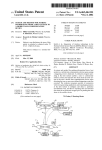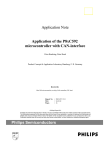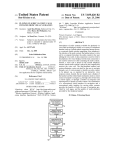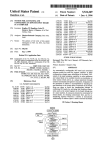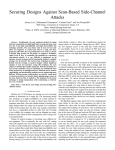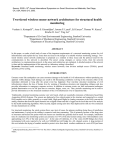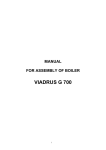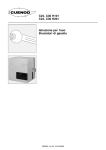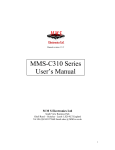Download System and method for assigning unique addresses to agents on a
Transcript
US006009479A United States Patent [19] [11] Patent Number: [45] Date of Patent: J effries [54] 6,009,479 Dec. 28, 1999 SYSTEM AND METHOD FOR ASSIGNING Attorney, Agent, or Firm—Skjerven, Morrill, MacPherson, UNIQUE ADDRESSES TO AGENTS ON A SYSTEM MANAGEMENT BUS Franklin & Friel LLP; Ken J. Koestner [75] Inventor: [73] Assignee; Del] USA, LP” Round Rock, Tex [57] Kenneth Layton J e?'ries, Leander, Tex. ABSTRACT _ _ A computer system including a bus master performs a method for automatically assigning addresses to agents on a bus. Addresses are automatically assigned so that a com [21] APPL NO; 08/866,678 [22] Filed? puter system user does not set physical or logical switches, either manually or through software programming. The May 30! 1997 system and method also automatically assign unique _ _ addresses to new devices that are inserted on the bus while Related U‘S‘Apphcatmn Data . [63] . . . the bus is operating, thereby supporting “hot pluggable” . devices. Slave agents are originally con?gured to operate at $5515n§§§f°§g§?g€gg§§f§P1“mnN°~ 08/389’849’Feb' 17’ a class address. At the beginning of the method, a master determines whether any of the slaves reside at the class [51] [58] Int. Cl.6 ............................. .. G06F 11/00; G06F 3/00 address If so, then the master determines a new unique U-S- Cl- ................................................. .. address and issues a Get Bitwise Field of Search ................................... .. 395/828, 829, residing at the class address. Each of the slaves receives the 395/830, 831, 832, 833, 874, 882; 710/8—14, 62 References Cited Get Bitwise UID and responsively transmits a hardware identi?cation (UID) in a loop of bitwise byte transmissions. One slave successfully transmits the hardware identi?cation (UID) while the other individual slaves detect transmission Us‘ PATENT DOCUMENTS errors during transmission 'of'the hardware identi?cation [56] 4,679,192 Command [0 the slaves (UID) and terminate transmission upon the error detection. The unsuccessful slaves, if previously residing at a unique 7/1987 Vanbrabant . 4,701,878 10/1987 Gl'inkel et al- - address, revert to the class address. The master receives the 47277475 2/1988 Kiremidjian - hardware identi?cation (UID) of the successfully transmit 4’773’OO5 9/1988 Sulhvan ' ting slave and issues a Set Address command in combination 5’204’669 a1 4/1993 D O rfe et a1: : 5/1994 Cuenod et aL _ with the hardware identi?cation (UID) and the new unique address to all slave agents at the class address. Only the slave agent with a hardware identi?cation (UID) matching the Celia ]L et a1_ _ Thomsen er a1, _ Whetsel . Di Giulio et a1- - UID of the Set Address command processes the Set Address command to completion and is assigned the address. The master uses the Get Bitwise UID command followed by the Set Address command in a loop to locate, identify and assign 575247269 1/1995 4/1995 1/1996 3/ 1996 6/1996 Hamilton et a1-- addresses to agents responding to a predetermined class 5,708,831 1/1998 Sch6n .................................... .. 395/829 5:317:693 5,379,437 5,404,460 5,483,518 5,499,374 address~ Primary Examiner—AyaZ R. Sheikh Assistant Examiner—David A. Wiley 31 Claims, 6 Drawing Sheets SMB slnve Response to GET’BITW'ISE’ULD Command Receive New GET’BITWISE um cnrnrnnnd Transmit UID an in Byte Transfer 504 Detect Transmission Errors 506 Transmission Error” Count Transmitted Bytes Ta'minate Transmission, Resume Responsiveness to cm Address 510 514 U.S. Patent Dec. 28, 1999 Sheet 3 of6 $1E1 in.in ?iE1 $1wa. E525Eaaesxw 6,009,479 2EE5 (95$2 E8 w wwv Fmow. m?mo Ei6R23n9E5F68 25N8E5556 m?QHc>w2.to=5aEcoz w 38028éow?ESaini0E84 " 31 $1 9 : m c 2 5 a o I t c m Mw?‘ .2? “WP in$2in. w9E9.5 6:R5EJ0Q.mE 8? .0 m _n_ U.S. Patent Dec. 28, 1999 Sheet 4 0f 6 6,009,479 SMB Master Is Class Address Occupied? 402 Wait Several Seconds 416 Detemrine New Address 404 Issue GET BII WISE UID Command 406 Receive UID From Agent 408 FIGURE 4 Issue SET ADDRESS Command 410 U.S. Patent Dec. 28, 1999 6,009,479 Sheet 5 0f 6 SMB Slave Response to GET_BITWISE_UID Command FIGURE 5 Receive New GET_BITWISE UID Command 502 Transmit UlD Bit in Byte Transfer 504 i Detect Transmission Errors 506 Transmission Error? 508 Count Transmitted Terminate Transmission, Resume Responsiveness Bytes to Class Address 514 5l0 N Last Byte? 5 12 U.S. Patent Dec. 28, 1999 Sheet 6 of6 6,009,479 SMB Slave Response to SET_ADDRESS Command Receive New SET_ADDRESS Command 602 Compare Local UID to Transmited UID 604 V Receive New Unique Address 608 9 Con?gure to New Unique Address 61 O FIGURE 6 ~11 @ 6,009,479 1 2 SYSTEM AND METHOD FOR ASSIGNING UNIQUE ADDRESSES TO AGENTS ON A SYSTEM MANAGEMENT BUS of hardWired interconnects, dip sWitches, or jumpers by a designer. The designer speci?es dip sWitch or jumper con nections and a computer system user either manually sets the dip sWitches or jumpers. Alternatively, the computer system This application is a continuation-in-part of copending patent application Ser. No. 08/389,849, ?led on Feb. 17, 1995, and entitled “System And Method For Assigning Unique Addresses To Agents On A System Management Bus”, by Kenneth L. Jeffries, now US. Pat. No. 5,636,342 and Which is incorporated herein by reference in its entirety. user uses con?guration softWare to operate logical sWitches. The manual setting of sWitches or manipulation of sWitches through softWare control is often tedious and error prone. What is needed is a system and method for automatically assigning addresses to agents on a serial system manage 10 BACKGROUND OF THE INVENTION 1. Field of the Invention The present invention relates to computer systems Which include a bus. More particularly, the present invention relates to a system and method for automatically assigning unique addresses to agents on a bus in a computer system. 2. Description of the Related Art cally assigning unique addresses to neW “hot-pluggable” agents that are subsequently connected to the bus. In accordance With one aspect of the present invention, a computer system including a bus master performs a method for automatically assigning addresses to agents on a bus. Addresses are automatically assigned so that a computer system user does not set physical or logical sWitches, either Computer systems generally include multiple devices manually or through softWare programming. The system and method also automatically assign unique addresses to neW devices that are inserted on the bus While the bus is 25 typically a local bus such as a peripheral component inter connect (PCI) bus. The local bus may then be connected to operating, thereby supporting “hot pluggable” devices. In an illustrative embodiment, the bus is a system man agement bus (SMB) operating according to an 12C serial protocol. The system management bus (SMB) includes one a more traditional expansion bus such as an AT bus or or more SMB masters and a plurality of SMB slaves. The Industry Standard Architecture (ISA) bus, an Extended ISA SMB master and SMB slaves perform predetermined moni (EISA) bus or a microchannel architecture (MCA) bus. toring and control operations in the computer system. The A computer system often includes a bus referred to as a SMB master performs a method for assigning unique addresses to each of the SMB slaves automatically and system management bus used for monitoring operations Within the system Without involvement of the host processor and/or Without requiring host processor operability. The system management bus operates in the background and SUMMARY OF THE INVENTION 15 interconnected by one or more various buses. For example, a typical computer system architecture includes a CPU connected to main memory through a host or memory bus. The host or memory bus is connected to an expansion bus. In modem computer architectures, the expansion bus is ment bus in a computer system Without user intervention. What is also needed is a system and method for automati Without user intervention. The disclosed method and system 35 for automatic assignment of addresses advantageously simpli?es, improves ef?ciency, and avoids error in assigning does not use CPU resources. Thus the system management addresses to bus agents in comparison to conventional bus operates independently of an operating system that controls the computer system. Therefore, the system man agement bus operates in parallel With and independently of manual and softWare programming techniques. In accordance With an embodiment of the present invention, the bus operates in compliance With a protocol other operations that are occurring on other buses Within the that includes a plurality of commands. TWo useful com computer system. mands are a Set Address command and a Get Identi?er A system management bus is typically used to connect command. A master sends the Get Identi?er command to slave agents on the bus at a class address. The individual devices called “agents”. Agents monitor operations of other devices in the system and made data accessible for display to a computer user. Examples of devices Which can be 45 slave agents respond to the Get Identi?er command by transmitting an identi?er identifying the agent. When the connected to a system management bus include monitoring master issues a Get Identi?er command using the agent class cards for monitoring disk drive functions, control panel address, the slave agents at the class address respond and exactly one slave agent successfully transmits an identi?er. consoles for displaying the status of the disk drives Within a system, and poWer supply monitors for monitoring and reporting the status of the poWer supply in the system, and A transmission error occurs When the data on the bus is different from the data sent by a slave. The slave agents that do not successfully transmit the identi?er detect a transmis sion error in the response, terminate transmission of the the like. Devices connected to a system management bus generally perform control functions so the bus speci?cation does not include high speed data transfer capabilities. Therefore a system management bus is typically implemented using a serial bus protocol. One popular serial bus protocol is an 12C identi?er response as a result of the error detection, and 55 assigning addresses to agents on the bus involves a selection assigned. The master sends the Set Address command accompanied by a unique address and an agent identi?er to all agent slaves residing at the class address. All slave agents at the class address receive the Set Address command but only the agent With the matching agent identi?er processes the Set Address command to completion and changes the bus address to the serial bus standard protocol developed by Phillips Corpo ration. In one implementation, the system management bus is implemented at the electrical level and the loWest protocol level using the 12C serial bus protocol. An additional pro tocol may then be run “on top” of the 12C bus to facilitate data transfers betWeen the devices. Each agent connected to a system management bus based on the 12C protocol is assigned a dedicated 12C address for proper operation of the bus. The conventional method for revert to the class address if a unique address Was previously unique address. In accordance With a more speci?c embodiment of the 65 present invention, the bus is a system management bus (SMB) operating under a special protocol in conjunction With a standard 12C protocol. The 12C protocol supports 6,009,479 3 4 several commands including a Set Address command and a Get BitWise UID command that are useful for automatically mission from SMB agents residing on the SMB at the class address. The SMB agents respond to the Get BitWise UID an executable program code for issuing a Get Identi?cation command via transmission on the communications medium, an executable program code for receiving a slave device identi?cation via transmission on the communications medium, and an executable program code for issuing a Set Address command via transmission on the communications request by transmitting a hardWare identi?er (UID) associ medium. The Set Address command designates the unique assigning addresses to SMB agents. The SMB master issues a Get BitWise UID command to evoke a responsive trans ated With the agent. The SMB agent transmits the hardWare address and the received slave device identi?cation. The identi?er (UID) one bit at a time With each bit transmitted as slave controller executes a program code including an a single byte. In an illustrative embodiment, the responsive byte is transmitted as either all one’s (Oxff) or all Zero’s (0x00). The SMB agents check for transmission errors 10 executable program code for receiving the Get Identi?cation command via transmission on the communications medium, and an executable program code responsive to receipt of the during the responsive transmission, terminate the responsive Get Identi?cation command for transmitting the ?xed slave transmission upon detection of an error, and revert to the device identi?cation via transmission on the communica class address if a unique address Was previously assigned. The SMB master receives the hardWare identi?er (UID) from the SMB agent that successfully transmits the UID. The SMB master determines a unique agent address and assigns the unique agent address to the SMB agent that 15 tions medium, detecting errors in transmission, and termi nating transmission upon detecting an error. The slave controller further executes an executable program code for receiving the Set Address command via transmission on the communications medium. The Set Address command successfully transmitted the hardWare identi?er (UID) using the Set Address command. The master issues the Set includes a received address and a received identi?cation. The slave controller further executes a program code includ Address command in combination With the unique agent address and the hardWare identi?er to all SMB agents. Only the SMB agent having a hardWare identi?er (US)) that ing an executable program code responsive to receipt of the Set Address command for comparing the received identi? cation and the ?xed slave device identi?cation to determine matches the hardWare identi?er included in the Set Address command processes the Set Address command to 25 completion, successfully changing the SMB address of the agent. In accordance With another aspect of the present invention, the SMB slave agents are originally con?gured to operate at a class address. At the beginning of the method, the SMB master determines Whether any of the SMB slaves reside at the class address. If so, then the SMB master hardWired interconnects, dip sWitches, or jumpers. The illustrative system and method also avoid tedious and error determines a neW unique address and issues a Get BitWise UID command to the slaves residing at the class address. Each of the slaves receives the Get BitWise UID and responsively transmits a hardWare identi?cation (UID) in a a match condition of matching or nonmatching and an executable program code for assigning the received address to the slave device When the match condition is matching. The described system and method achieves many advan tages. It is advantageous that the system and method alloWs multiple devices to be easily and correctly connected to a single master control device. Unique addresses are correctly set for the multiple devices Without manual selection of 35 prone manual setting of sWitches or manipulation of sWitches through softWare control, It is advantageous that hardWare identi?cation is desig loop of bitWise byte transmissions. One slave successfully nated on a per-agent basis so that a master device can transmits the hardWare identi?cation (UID) While the other associate context With a hardWare (UID) identi?ed agent individual slaves detect transmission errors during transmis rather than an address-identi?ed agent. As agents are added or removed due to disconnection and reconnection to the sion of the hardWare identi?cation (UID) and terminate bus, thereby alloWing hot-plugging, context is reassociated With hardWare (UID) identi?ed agents rather than being transmission upon the error detection. The unsuccessful slaves, if previously residing at a unique address, revert to the class address. The SMB master receives the hardWare identi?cation (UID) of the successfully transmitting slave discarded and recreated. 45 and issues a Set Address command in combination With the hardWare identi?cation (UID) and the neW unique address to all slave agents at the class address. Only the slave agent With a hardWare identi?cation (UID) matching the UID of BRIEF DESCRIPTION OF THE DRAWINGS The features of the described embodiments believed to be novel are speci?cally set forth in the appended claims. the Set Address command processes the Set Address com HoWever, embodiments of the invention relating to both structure and method of operation, may best be understood mand to completion and is assigned the SMB address. by referring to the folloWing description and accompanying draWings. The master uses the Get BitWise UID command folloWed FIG. 1 is a schematic block diagram illustrating a com by the Set Address command in a loop to locate, identify and assign SMB addresses to agents responding to a predeter executed exactly once for each of the slave agents connected puter system including a system management bus that is suitable for implementing an embodiment of the system and method of the present invention. to the bus, avoiding unnecessary instruction cycles, latency, and expenditure of energy. FIG. 2 is a schematic block diagram illustrating an alternate embodiment of the computer system of FIG. 1 and In accordance With an embodiment of the present invention, an apparatus includes a communications medium, including a dedicated SMB master Which is connected to an mined class address. The operating loop is advantageously 55 expansion bus of the computer system. FIG. 3 is a schematic block diagram illustrating a com a master device connected to the communications medium and a slave device connected to the communications medium. The master device includes a master controller. The slave device includes a slave controller and a hardWare identi?er designating a ?xed slave device identi?cation. The puter system including a system management bus, a system unit, and an external disk drive unit. FIG. 4 is a ?oWchart diagram illustrating operation of the 65 SMB master Which issues Get BitWise UID and Set Address master controller executes a program code including an commands for assigning unique addresses to SMB agents executable program code for determining a unique address, according to an embodiment of the present invention. 6,009,479 6 5 connectivity betWeen various monitoring devices in a sys tem. The various monitoring devices connected to the bus 180 operate Without involvement of the host processor 102 FIG. 5 is a ?owchart diagram illustrating the response of an SMB agent to a Get BitWise UID command. FIG. 6 is a ?owchart diagram illustrating the response of and operate independently of the operating system. an SMB agent to a Set Address command. In the embodiment shoWn in FIG. 1, the SMB bus includes a plurality of slaves or agents, including tWo or DESCRIPTION OF THE ILLUSTRATIVE more thermal monitoring cards (TMCs) 184A and 184B and EMBODIMENT(S) Referring to FIG. 1, a schematic block diagram illustrates a computer system Which incorporates a plurality of buses or other communications media including a system manage ment bus and is suitable for implementing a system and one or more control panel consoles 192. Thermal monitoring 10 cards (TMCs) are depicted for exemplary purposes only. In other embodiments, other types of SMB agents may be employed that are not used for thermal monitoring. The TMCs 184A and 184B each measure the temperature and operating method for assigning unique addresses to agents voltages of crucial components Within the system. For on a bus. The system and method operate to assign unique example, in one embodiment the TMCs 184A and 184B are addresses to devices connected to a bus such as a serial bus 15 each physically situated near a grouping of one or more hard or, more speci?cally for some embodiments, a serial system assigning unique addresses to agents on a bus may be used drives, and each TMC 184A and 184B monitors tempera tures and voltage ?uctuations of the respective grouping of hard drives, the associated fan and poWer supply, and the With various types of serial buses and may be incorporated into any of various types of computer systems. As shoWn, voltages of one or more drives are not Within prede?ned management bus. The system and operating method for TMC itself. If the temperature and/or certain measured the computer system includes a processor 102 such as a tolerances, the respective thermal monitoring card sounds an alarm, Which may include turning on LEDs Within the respective control panel console 192 or sounding a speaker. Therefore, each thermal monitoring card (TMC) 184A and central processing unit (CPU) Which is connected through a processor local bus 104 to a host/PCI/cache bridge 106. The bridge 106 connects through a memory bus 108 to a main memory 110. The host/PCI/cache bridge 106 also interfaces to a peripheral component interconnect (PCI) bus 120. In the illustrative embodiment, a PCI local bus is used. HoWever, 25 184B performs thermal and voltage monitoring operations on a grouping of disk drives in the computer system. For more information on the thermal monitoring cards, please it is noted that other local buses may be used, such as the see the Dell PoWerEdge SP 590-2 System User’s Guide, VESA (Video Electronics Standards Association) VL bus. Appendix C, available from Dell Computer Corporation, Austin Tex., Which is hereby incorporated by reference. Various types of devices are connected to the PCI bus 120. In the embodiment shoWn in FIG. 1, a video adapter 170 and Please also see the Dell PoWerEdge XE 590-2 System video frame buffer 172 are connected to the PCI bus 120 for Service Manual, available from Dell, Which is hereby incor controlling video functions. A SCSI (small computer sys porated by reference. tems interface) adapter 122 is connected to the PCI bus 120. In the illustrative embodiment, the SCSI adapter 122 includes ?rmWare Which enables the adapter 122 to operate adapter 122 includes a SCSI channel 123 Which may have various connected devices. In the embodiment shoWn in FIG. 1, the SCSI channel 123 includes four disk drive units 124. It is noted that other devices may be connected to the SCSI channel 123, as desired. Various other devices may be The control panel console 192 monitors the status of the hard drives and includes a plurality of LEDs for indicating the status. For example, a respective LED may be red to indicate the disk drive is not operational, orange to indicate that the hard drive is inactive, and green to indicate that the hard drive is currently being accessed. It is noted that other types of SMB slaves may be comprised Within the system Which perform other functions, as desired. In the illustrative embodiment, each SMB slave includes a Phillips connected to the PCI bus 120, such as a netWork interface PCB83C552 Microprocessor. 35 as an SMB master as discussed hereinafter. The SCSI card 140. As shoWn, the netWork interface card 140 inter faces to a local area netWork (LAN) 142. 45 In the illustrative embodiment, the SCSI adapter 122 includes ?rmWare Which enables the adapter 122 to operate Expansion bus bridge logic 150 is also connected to the PCI bus 120. The expansion bus bridge logic 150 interfaces FIG. 2, in an alternate and equally illustrative embodiment, to an expansion bus 152. The expansion bus may be any of the SMB master is con?gured as a separate dedicated varying types, including the industry standard architecture microcontroller 202 connected to the expansion bus 152. It is noted that various other con?gurations may be used, as desired. Referring noW to FIG. 3, in one embodiment the computer system includes a system unit 302 and a separate external disk drive storage unit 304 for storing additional disk drives. In this embodiment, the system management bus 180 con nects betWeen the system unit 302 and the external disk as a system management bus (SMB) master. As shoWn in (ISA) bus, also referred to as the AT bus, the extended industry standard architecture (EISA) bus, or the microchan nel architecture (MCA) bus. Various devices may be con nected to the expansion bus 152, including expansion bus memory 154 and a modem 156. The expansion bus bridge logic 150 also connects to a peripheral expansion bus 55 referred to as an X-bus 160. The X-bus 160 is used for connecting various peripherals to the computer system. As shoWn, an interrupt system 162, a real time clock (RTC) and timers 164, a direct memory access (DMA) system 166, and drive unit 304, and one or more monitoring devices com prised in the system unit 302 and the external disk drive unit 304 connected to the system management bus 180. As shoWn, the system unit 302 of the computer system includes a plurality of devices connected to the system management bus 180, including tWo thermal monitoring cards 184A and 184B, a control panel console 192, and an SMB master. The computer system unit 302 also includes the various com ROM/Flash memory 168 are connected to the X-bus 160. Other peripherals (not shoWn) are connected to the X-bus 160, including communications ports, diagnostics ports, command/status registers, non-volatile static random access memory (NVSRAM), etc. The computer system shoWn in FIG. 1 includes a system management bus 180 as shoWn. As discussed in the back ground section, the system management bus 180 provides 65 puter system components shoWn in FIG. 1, although these elements are not shoWn in FIG. 3 for simplicity. The external disk drive unit 304 includes a plurality of hard drives 124 6,009,479 7 8 and one or more monitoring devices connected to the system management bus 180, such as one or more thermal moni Which utiliZe a system management bus, the computer toring cards 184A and 184B as shoWn. either of FIGS. 1, 2 or 3. Each SMB slave is speci?ed to have its oWn SMB/12C address. A designer hardWires a system may include tWo or more SMB slaves, as shoWn in In the illustrative embodiment, the system management bus 180 is implemented using the Phillips 12C serial bus. More speci?cally, in the illustrative embodiment the system management bus is implemented at the electrical level and the loWest protocol level using the 12C serial bus protocol. An additional protocol is used “on top” of the 12C bus Which de?nes various bus commands to facilitate data transfers betWeen the devices. The 12C bus comprises three lines including a serial data logical address or the unique address is provided by the user manually operating DIP sWitches or jumpers or using con ?guration softWare to operate logical sWitches. This speci ?cation to manually or programmatically set addresses of SMB agents can be both tedious and error prone. Therefore, 10 the disclosed system and operating method assign unique addresses to SMB agents Without user involvement. Referring to FIG. 4, a ?oWchart diagram illustrates opera tion of a System Management Bus (SMB) master automati line (not shoWn), a clock line (not shoWn), and a ground Wire (not shoWn). Each agent connected to the 12C bus includes cally assigning addresses to various system management an open collector or dot-or connection to the data line. Thus, 15 (SMB) slaves in a computer system. In operation 402 the if an agent desires to transmit a logical Zero on the data line, SMB master ?rst determines if any of the SMB slaves reside the agent pulls the line loW. An agent transmits a logical high at an address referred to as the class address. The class value on the line by simply ?oating the line high, i.e., not is hereby incorporated by reference in its entirety. address is a default address of all agents of a particular type. At initialiZation, all of the SMB slaves are initially con?g ured to operate at class addresses speci?ed for de?ned agent classes. For eXample, all TMCs are initially con?gured to respond at a ?rst or “TMC” class address, all control panel As mentioned above, the SMB bus can include a plurality of devices or agents connected to the bus. Each SMB agent “control panel” class address, and the like. driving the line. For more information on the Phillips 12C serial bus please see the Signetics 12C Peripherals for Microcontrollers Handbook, published January 1992 Which consoles are initially con?gured to respond to a second or is a processor, controller, microcontroller or the like that can 25 If one or more of the SMB slaves reside at the class operate either in a master or slave mode and can also operate address in operation 402, then in operation 404 the SMB as either a transmitter or receiver. The difference betWeen an master determines a neW unique address for the SMB slaves. SMB master and an SMB slave is that the master initiates In operation 406 the SMB master issues a Get BitWise UID transactions on the bus. For eXample, the master arbitrates command to SMB slaves that reside at the class address. The and gains oWnership of the bus and then initiates a transfer. SMB master issues a Get BitWise UID command to evoke a Therefore, the master initiates operations ?rst, performs responsive transmission from SMB agents residing on the SMB at the class address. The operation of the SMB slaves arbitration to gain control of the bus and then performs a transmission Which includes addressing a slave. For eXample, the master can gain control of the bus, address a slave, and then may either transfer data to the slave or direct the slave to transmit information to the master. Thus, the master may reverse transmission directions in cooperation in response to a Get BitWise UID command is discussed further in the description of FIG. 5 hereinafter. In operation 35 With the addressed slave and thus may either send data to a slave or receive data from a slave. Therefore, each 12C bus agent is either a master or a slave and also is orthogonally either in transmitter mode or receiver mode. master issues a Set Address command to the SMB slaves. The SMB master issues the Set Address command in com bination With the unique agent address and the hardWare identi?er (UID) to all SMB slaves. Only the SMB slave having a hardWare identi?er (UID) that matches the hard The 12C serial bus protocol provides for arbitration betWeen multiple masters attempting to simultaneously access the bus. Arbitration is performed by each master by eXamining the data actually transmitted on the bus and comparing the transmitted data to the data that the respective master is attempting to transmit. The 12C data line is a dot-or serial bus Where bits from each byte are transmitted serially on the bus. According to the 12C speci?cation, master 408 the SMB master receives a hardWare identi?cation (UID) transmitted by one of the SMB slaves, the SMB slave that successfully transmits the UID in response to the Get BitWise UID command. In an operation 410, the SMB Ware identi?er included in the Set Address command pro 45 cesses the Set Address command to completion. At comple tion of the Set Address process, the SMB address of the slave is modi?ed to the assigned unique address. The operations performed by the SMB agents or slaves in response to the Set Address command is discussed further hereinafter in the discussion of FIG. 6. One SMB slave alWays responds to the Set Address command issued in operation 410 so that transmission errors by SMB slaves that do not respond to the Set Address command are ignored. transmitter hardWare examines each bit actually appearing on the bus and compares it With each bit the master is attempting to transmit on a bit-by-bit basis. A master trans mitter ceases transmission if a mismatch occurs. The master transmitter that is not “in error,” i.e., the remaining master In operation 402 if none of the SMB slaves are determined transmitter Which has not detected an error, is able to 55 to reside at the class address, then each of the SMB slaves continue its transmission. Thus, arbitration betWeen multiple SMB masters is performed “on the ?y” during transmission. has received a unique address different from the beginning class address. In this case, in operation 416 the SMB master Waits a period of seconds and during this time other opera No agent eXcept the one or more master transmitters in error knoWs that there has been any problem, and the one or more master transmitters in error are free to try their transmissions again at a later time. tions are performed on the system management bus. After a certain period of time has elapsed, for eXample tWo or three seconds, the SMB master returns to operation 402 and repeats the process. Thus, the SMB master periodically performs the illustrative method. The 12C serial bus protocol de?nition does not specify a particular comparison logic for SMB slaves. Therefore, components operating in slave mode are generally not con?gured With this bit comparison logic. Agents connected to the 12C bus are addressed using a unique seven-bit code or address. In computer systems If a neW SMB slave is added to the SMB bus, then Within 65 a short period the SMB master performs the above steps and automatically assigns a neW unique address to the SMB slave added. Since the SMB master periodically performs 6,009,479 9 10 the automatic con?guration to assign unique addresses to the If the SMB slave detects an error after the transmission of SMB slaves, a neW SMB slave is “hot pluggable” into the SMB bus. AneW SMB slave subsequently added to the SMB bus receives a unique address Without user intervention. Referring to FIG. 5, a ?oWchart diagram illustrates the operation of an SMB slave responding to a Get BitWise UID command. In operation 502 the SMB slave receives the Get a byte in operation 504 then, directed by the decision operation 508, in operation 514 the SMB slave ceases responding to a unique address, if a unique address Was previously assigned and operative, and reverts to respon siveness to the class address. In summary, the SMB slave agents respond to a Get BitWise UID command. In response to a Get BitWise UID BitWise UID command by checking for transmission errors command, the SMB slave transmits a hardWare identi?ca during the responsive transmission, terminating the respon tion uniquely associated With the SMB slave device. The agent devices connected to the system management bus 180, such as the tWo thermal monitoring cards 184A and 184B, the control panel console 192, and the SMB master include sive transmission upon detection of an error, and reverting to the class address if a unique address Was previously an identi?cation hardWare. One suitable identi?cation hard Ware is a Dallas Semiconductor model DS2401 enhanced Silicon Serial Number identi?cation hardWare manufactured 15 by Dallas Semiconductor of Dallas, TeX., that supplies a 64-bit unique hardWare identi?cation for an SMB agent. Accordingly, each SMB agent or slave has a 64-bit unique detect transmission errors during transmission of the hard Ware identi?cation (UID) and terminate transmission upon the error detection. The unsuccessful slaves, if previously residing at a unique address, revert to the class address. Referring to FIG. 6, a ?oWchart diagram illustrates the identi?cation. An advantage of having the hardWare identi ?cation designated on a per-agent basis is that a master device can associate conteXt With a hardWare (UID) identi ?ed agent rather than an address-identi?ed agent. As agents response of an SMB agent to a Set Address command of a are added or removed due to disconnection and reconnection to the bus, thereby alloWing hot-plugging, conteXt is reas sociated With hardWare (UID) identi?ed agents rather than being discarded and recreated. In operation 504, the SMB slave transmits a single bit of the 64-bit hardWare identi?cation (UID). The SMB agent 25 compares the received hardWare identi?cation (UID) trans mitted via the Set Address command to the hardWare iden ti?cation (UID) associated, generally by hardcoding, With the SMB slave. If the received and associated hardWare agents normally detect transmission errors due to multiple identi?cations (UIDs) match, as determined by the decision operation 606, the SMB agent receives the neW unique slaves simultaneously transmitting on byte boundaries. Since only a bit of information is transmitted in each 35 errors on a bit boundary. In an illustrative embodiment, the address. If the encoded hardWare identi?cation (UID) of the SMB slave does not match the transmitted hardWare identi?cation (UID) to the SMB master one bit per byte at a time. In the illustrative embodiment, the SMB agent identi?cation, as determined by the decision operation 606, then the SMB slave response to the Set Address command transmits 64 bytes to the SMB master. By convention, the SMB data is “little endian” so that 64 bytes, representing 64 bits, are transmitted least signi?cant bit ?rst. After transmission of a byte representing a single bit of terminates Without setting the agent address. In summary, the SMB master sends the Set Address command to all SMB agents at a predetermined class 45 the SMB slave detects transmission errors during transmis sion of the byte in operation 506. The SMB slave samples the data bus When the slave transmits data but does not automatically respond if a miscompare occurs. The SMB slave makes available the entire byte of actually transmitted data and a program eXecuting on the processor compares the actual transmitted byte to the byte intended for transmission to determine Whether a transmission error has occurred. If an error is not detected according to decision operation 508, then in operation 510 the SMB slave updates a count of the number of transmitted bytes and determines Whether the 55 address, the Set Address command including the hardWare identi?cation (UID) argument and the neW unique address argument. All SMB agents at the class address receive the Set Address command, but only the single SMB agent With a hardWare identi?cation (UID) matching the transmitted identi?cation changes assigned address to the neW unique address. While the invention has been described With reference to various embodiments, it Will be understood that these embodiments are illustrative and that the scope of the invention is not limited to them. Many variations, modi?cations, additions and improvements of the embodi transmitted byte is the last byte of the identi?cation bytes. In the illustrative embodiment, the last byte is the 64th trans mitted byte. If the last byte is transmitted as determined by decision operation 512, the response to the Get BitWise UID ments described are possible. For example, those skilled in the art Will readily implement the steps necessary to provide the structures and methods disclosed herein, and Will under stand that the process parameters, materials, and dimensions are given by Way of eXample only and can be varied to operation completes successfully. If the transmitted byte is not the last byte in the transfer of the slave identi?cation bytes, the decision operation 512 directs that the SMB slave achieve the desired structure as Well as modi?cations Which are Within the scope of the invention. Variations and modi ?cations of the embodiments disclosed herein may be made returns to operation 504 and transmits the neXt hardWare identi?cation (UID) byte. The SMB slave repeats operations 504, 506, 508, 510, and 512 until all hardWare identi?cation (UID) bytes are transmitted. address from the SMB master in an operation 608 and the SMB slave con?gures to the neW unique address in opera tion 610, completing the operation of assigning the unique responsive byte is transmitted as either all one’s (Oxff) or all Zero’s (0x00). The SMB agent transmits the hardWare the 64-bit hardWare identi?cation (UID) in operation 504, SMB master. In operation 602 the SMB slave receives the Set Address command. The Set Address command is issued by the SMB master in combination With arguments includ ing the unique agent address and the hardWare identi?cation (UID) to all SMB slaves. In operation 604 the SMB slave transmits the hardWare identi?er (UID) one bit at a time With each bit transmitted as a single byte. The individual bits are formatted into bytes for transmission because SMB slaves or transmitted byte, slaves effectively detect transmission assigned. Each of the slaves receives the Get BitWise UID and responsively transmits the hardWare identi?cation (UID) associated to the slave in a loop of bitWise byte transmissions. One slave successfully transmits the hard Ware identi?cation (UID) While all other individual slaves 65 based on the description set forth herein, Without departing from the scope and spirit of the invention as set forth in the folloWing claims. 6,009,479 11 12 What is claimed is: hardWare identi?er designating a ?xed slave device identi?cation. 1. An apparatus comprising: 4. An apparatus according to claim 1, further comprising: a communications medium; a master device coupled to the communications medium, the master device including a master controller; _ _ _ a plurality of slave devices coupled to the communica 5 _ tions medium.’ individual. Slave devices of the plurality of slave devices including a slave controller and a a Slave device cciuplfid to the Communications medium’ hardWare identi?er designating a ?xed slave device the slave device including a slave controller and a hardware identi?er designating a ?xed Siave device identi?cation, wherein. the ?xed slave device identi?cation is a multiple-bit identi?cation; 1O a program code executable by the master controller identi?cation; and the executable program code executable by the indi including: vidual slave devices and responsive to receipt of the an executable program code for determining a unique address; an executable program code for issuing a Get Identi- 15 ?cation command via transmission on the communications medium; an executable program code for receiving a slave Get Identi?cation command for transmitting the ?xed slave device identi?cation via transmission on the communications medium, detecting errors in transmission, and terminating transmission upon detecting an error further includes: an executable program code for transmitting the ?xed slave device identi?cation in a plurality of device identi?cation via transmission on the com- munications medium; and 20 one-byte transmissions, one byte corresponding to an executable program code for issuing a Set Address command via transmission on the communications one bit of the multiple-bit ?xed slave device identi?cation; medium, the Set Address command designating the unique address and the received slave device iden- an executable program code for detecting transmis sion errors on a byte boundary corresponding to a bit boundary of the multiple-bit ?xed slave device identi?cation 5. An apparatus according to claim 4, Wherein: the executable program code executable by the individual slave devices and responsive to receipt of the Get Identi?cation command for transmitting the ?xed slave ti?cation; and 25 a program code executable by the slave controller of the slave device including; an executable program code for receiving the Get Identi?cation command via transmission on the communications medium; 30 an executable program code responsive to receipt of the Get Identi?cation command for transmitting the ?xed slave device identi?cation via transmission on the communications medium, detecting errors in transmission of individual bytes of the ?xed slave 35 device identi?cation, sampling and comparing the individual transmitted bytes With bytes intended for transmission to detect transmission errors, updating a count of the number of transmitted bytes if no transmission error is detected, determining Whether a 40 last byte of the ?xed slave identi?cation bytes has been transmitted, terminating transmission upon detecting an error, and reverting to a class address and ceasing to respond to the unique address if a unique address Was previously assigned; 45 an executable program code for receiving the Set Address command via transmission on the commuIliCaIiOIlS Inedillm?he SeIAddreSS COIIlHlaIld inClllding a received address and a received identi?cation; an executable program code responsive to receipt of the 50 Set Address command for comparing the received identi?cation and the ?xed slave device identi?ca tion to determine a match condition of matching or nonmatching; and an executable program code for assigning the received 55 address to the slave device When the match condition is matching. 2. An apparatus according to claim 1, Wherein the pro gram code executable by the slave controller of the slave device further includes: 60 an executable program code for reverting to an assign ment of a class address to the slave device When the match condition is nonmatching. 3. An apparatus according to claim 1, further comprising: a plurality of slave devices coupled to the communica- 65 tions medium, individual slave devices of the plurality of slave device including a slave controller and a device identi?cation via transmission on the commu nications medium, detecting errors in transmission, and terminating transmission upon detecting an error fur ther includes: an executable program code for transmitting the ?xed slave device identi?cation in a plurality of one-byte transmissions, one byte corresponding to one bit of the multiple-bit ?xed slave device identi?cation; an executable program code for comparing data on the communications and the most recent of the one byte transmissions and determining a matching condition or a nonmatching condition, and an executable program code for terminating transmis sion When the nonmatching condition is determined. 6. An apparatus according to claim 1, further comprising: a plurality of slave devices coupled to the communica tions medium, individual slave devices of the plurality of slave devices including a slave controller and a hardWare identi?er designating a ?xed slave device identi?cation, Wherein the program code executable by the master controller further includes: an executable program code for looping a plurality of iterations and setting unique addresses for the plu rality of slave devices. 7. An apparatus according to claim 1, further comprising: a plurality of slave devices of a single class coupled to the communications medium, individual slave devices of the plurality of slave devices including a slave control ler and a hardWare identi?er designating a ?xed slave device identi?cation, Wherein the program code execut able by the master controller further includes: an executable program code for looping a plurality of iterations and setting unique addresses for the plu rality of slave devices in the single class. 8. An apparatus according to claim 1, further comprising: a plurality of N slave devices in a single class coupled to the communications medium, individual slave devices 6,009,479 14 13 15. A computer program product comprising: a computer usable medium having computable readable of the plurality of slave devices including a slave controller and a hardware identi?er designating a ?xed slave device identi?cation, Wherein the program code executable by the master controller further includes: code embodied therein including the program code executable by the master controller according to claim 11. 16. Aslave device operable in connection With a computer system including a communications medium for connection an executable program code for looping a N iterations and setting unique addresses for the N slave devices in the single class. 9. An apparatus according to claim 1, further Wherein: to the slave device, and a master device connected to the the hardWare identi?er is an SMB agent identi?er. communications medium, the slave device comprising: 10. A computer program product comprising: a computer usable medium having computable readable code embodied therein including the program code executable by the master controller and the program code executable by the slave controller according to claim 1. 11. A master device for controlling a plurality of slave devices, the master device and the plurality of slave devices being coupled by a communications medium, the master a slave controller; a hardWare identi?er coupled to the slave controller designating a ?xed slave device identi?cation; and a program code executable by the slave controller of the 15 an executable program code responsive to receipt of the Get Identi?cation command for transmitting the a master controller; and a program code executable by the master controller ?xed slave device identi?cation via transmission on including: the communications medium, detecting errors in transmission of individual bytes of the ?xed slave an executable program code for determining a unique address; 25 ?cation command to the plurality of slave devices via transmission on the communications medium; an executable program code for receiving a slave device identi?cation, sampling and comparing the individual transmitted bytes With bytes intended for transmission to detect transmission errors, updating a count of the number of transmitted bytes if no transmission error is detected, determining Whether a last byte of the ?xed slave identi?cation bytes has been transmitted, terminating transmission upon device identi?cation via transmission on the com munications medium, the slave device identi?cation being sent by a slave device that successfully trans mits the slave device identi?cation, the slave device detecting errors in transmission of individual bytes of a ?xed slave device identi?cation, sampling and comparing individual transmitted bytes With bytes an executable program code for receiving a Get Iden ti?cation command transmitted on the communica tions medium by the master device; device comprising: an executable program code for issuing a Get Identi slave device including: detecting an error, and reverting to a class address and ceasing to respond to the unique address if a unique address Was previously assigned; 35 intended for transmission to detect transmission errors, updating a count of the number of transmitted bytes if no transmission error is detected, determin an executable program code for receiving a Set Address command transmitted on the communications medium, the Set Address command including a received address and a received identi?cation; an executable program code responsive to receipt of the Set Address command for comparing the received identi?cation and the ?xed slave device identi?ca ing Whether a last byte of the ?xed slave identi?ca tion bytes has been transmitted, terminating trans mission upon detecting an error, and reverting to a tion to determine a match condition of matching or class address and ceasing to respond to the unique address if a unique address Was previously assigned; nonmatching; and an executable program code for assigning the received address to the slave device When the match condition and is matching. an executable program code for issuing a Set Address command via transmission on the communications 17. A slave device according to claim 16, Wherein the program code executable by the slave controller of the slave device further includes: medium, the Set Address command designating the unique address and the received slave device iden ti?cation. an executable program code for reverting to an assign ment of a class address to the slave device When the 12. A master device according to claim 11, further com prising: match condition is nonmatching. 18. A system operable in connection With a computer system including a communications medium for connection an executable program code for looping a plurality of iterations and setting unique addresses for the plurality of slave devices. 13. A master device according to claim 11, Wherein the plurality of slave devices include a plurality of slave devices of a single class, the master device further comprising: an executable program code for looping a plurality of to the system, and a master device connected to the com 55 iterations and setting unique addresses for the plurality munications medium, the system comprising: a slave controller; a hardWare identi?er coupled to the slave controller designating a ?xed slave device identi?cation; and a program code executable by the slave controller of the of slave devices in the single class. 14. A master device according to claim 11, Wherein the plurality of slave devices include a plurality of N slave devices in a single class, the master device further compris slave device including: ing: an executable program code responsive to receipt of the Get Identi?cation command for transmitting the an executable program code for looping a N iterations and 65 an executable program code for receiving a Get Iden ti?cation command transmitted on the communica tions medium by the master device; setting unique addresses for the N slave devices in the ?xed slave device identi?cation via transmission on single class. the communications medium, detecting errors in 6,009,479 15 16 transmission of individual bytes of the ?xed slave transmissions and determining a matching condition device identi?cation, sampling and comparing the individual transmitted bytes With bytes intended for or a nonmatching condition, and an executable program code for terminating transmis transmission to detect transmission errors, updating sion When the nonmatching condition is determined. 22. Amethod of con?guring a system including a plurality a count of the number of transmitted bytes if no transmission error is detected, determining Whether a of devices connected to a communications medium, the devices including a master device and a slave device, the slave device including a hardWare identi?er designating a last byte of the ?xed slave identi?cation bytes has been transmitted, terminating transmission upon detecting an error, and reverting to a class address ?xed slave device identi?cation, the method comprising: determining a unique address; and ceasing to respond to the unique address if a unique address Was previously assigned; issuing a Get Identi?cation command from the master device via transmission on the communications an executable program code for receiving a Set Address command transmitted on the communications medium; medium, the Set Address command including a received address and a received identi?cation; an executable program code responsive to receipt of the Set Address command for comparing the received identi?cation and the ?xed slave device identi?ca receiving the Get Identi?cation command at the slave device via transmission on the communications medium; on receipt of the Get Identi?cation command at the slave tion to determine a match condition of matching or device, transmitting from the slave device the ?xed nonmatching; and slave device identi?cation via transmission on the communications medium, detecting errors in transmis sion of individual bytes of the ?xed slave device an executable program code for assigning the received address to the slave device When the match condition identi?cation, sampling and comparing the individual transmitted bytes With bytes intended for transmission is matching. 19. A system according to claim 18, further comprising: a plurality of slave devices coupled to the communica 25 tions medium, individual slave devices of the plurality detected, determining Whether a last byte of the ?xed slave identi?cation bytes has been transmitted, termi of slave devices including a slave controller and a hardWare identi?er designating a ?xed slave device identi?cation. nating transmission upon detecting an error, and revert ing to a class address and ceasing to respond to the unique address if a unique address Was previously 20. A system according to claim 18, further comprising: a plurality of slave devices coupled to the communica assigned; tions medium, individual slave devices of the plurality of slave devices including a slave controller and a hardWare identi?er designating a ?xed slave device identi?cation, Wherein: 35 the ?xed slave device identi?cation is a multiple-bit receiving the Set Address command at the slave device via transmission on the communications medium, the Set Address command including a received address and ?xed slave device identi?cation via transmission on the communications medium, detecting errors in a received identi?cation; on receipt of the Set Address command at the slave transmission, and terminating transmission upon detecting an error further includes: device, comparing the received identi?cation and the 45 one bit of the multiple-bit ?xed slave device identi?cation; 23. A method according to claim 22, further comprising: an executable program code for detecting transmis reverting to an assignment of a class address to the slave sion errors on a byte boundary corresponding to a device When the match condition is nonmatching. 24. A method according to claim 22, Wherein the plurality bit boundary of the multiple-bit ?xed slave device identi?cation. 55 device identi?cation via transmission on the commu nications medium, detecting errors in transmission, and terminating transmission upon detecting an error fur ther includes: an executable program code for transmitting the ?xed slave device identi?cation in a plurality of one-byte transmissions, one byte corresponding to one bit of the multiple-bit ?xed slave device identi?cation; an executable program code for comparing data on the communications and the most recent of the one byte ?xed slave device identi?cation to determine a match condition of matching or nonmatching; and assigning the received address to the slave device When the match condition is matching. one-byte transmissions, one byte corresponding to 21. A system according to claim 20, Wherein: the executable program code executable by the individual slave devices and responsive to receipt of the Get Identi?cation command for transmitting the ?xed slave receiving a slave device identi?cation at the master device via transmission on the communications medium; and issuing a Set Address command from the master device via transmission on the communications medium, the Set Address command designating the unique address and the received slave device identi?cation; and identi?cation; and the executable program code executable by the indi vidual slave devices and responsive to receipt of the Get Identi?cation command for transmitting the an executable program code for transmitting the ?xed slave device identi?cation in a plurality of to detect transmission errors, updating a count of the number of transmitted bytes if no transmission error is 65 of devices includes: a plurality of slave devices coupled to the communica tions medium, individual slave devices of the plurality of slave device including a hardWare identi?er desig nating a ?xed slave device identi?cation. 25. A method according to claim 22, Wherein: the plurality of devices includes a plurality of slave devices coupled to the communications medium, indi vidual slave devices of the plurality of slave devices including a hardWare identi?er designating a ?xed slave device identi?cation, the ?xed slave device iden ti?cation being a multiple-bit identi?cation; and the operations of transmitting the ?xed slave device identi?cation via transmission on the communications 6,009,479 17 18 medium, detecting errors in transmission, and termi designating a ?Xed slave device identi?cation, the method nating transmission upon detecting an error further includes: further comprising: looping a plurality of iterations and setting unique transmitting from the slave device the ?xed slave device identi?cation in a plurality of one-byte transmissions, one byte corresponding to one bit of the multiple-bit ?xed slave device identi?cation; addresses for the plurality of slave devices. 28. A method according to claim 22, Wherein the plurality of devices includes a plurality of slave devices of a single class coupled to the communications medium, individual slave devices of the plurality of slave device including a detecting transmission errors on a byte boundary cor responding to a bit boundary of the multiple-bit ?Xed slave device identi?cation. 26. A method according to claim 22, Wherein: the operations of transmitting the ?Xed slave device hardWare identi?er designating a ?Xed slave device identi?cation, the method further comprising: looping a plurality of iterations and setting unique addresses for the plurality of slave devices in the single identi?cation via transmission on the communications class. medium, detecting errors in transmission, and termi nating transmission upon detecting an error further include: 15 of devices includes a plurality of N slave devices in a single class coupled to the communications medium, individual slave devices of the plurality of slave device including a transmitting from the slave device the ?Xed slave device identi?cation in a plurality of one-byte transmissions, one byte corresponding to one bit of the multiple-bit ?Xed slave device identi?cation; hardWare identi?er designating a ?Xed slave device identi?cation, the method further comprising: looping a N iterations and setting unique addresses for the comparing data on the communications and the most recent of the one byte transmissions and determining a matching condition or a nonmatching condition, and terminating transmission When the nonmatching con dition is determined. 27. A method according to claim 22, Wherein the plurality of devices includes a plurality of slave devices coupled to the communications medium, individual slave devices of the plurality of slave devices including a hardWare identi?er 29. A method according to claim 22, Wherein the plurality N slave devices in the single class. 30. A method according to claim 22, Wherein: the hardWare identi?er is an SMB agent identi?er. 25 31. A computer program product comprising: a computer usable medium having computable readable code embodied therein including a program code for performing a method according to claim 22. * * * * *
















